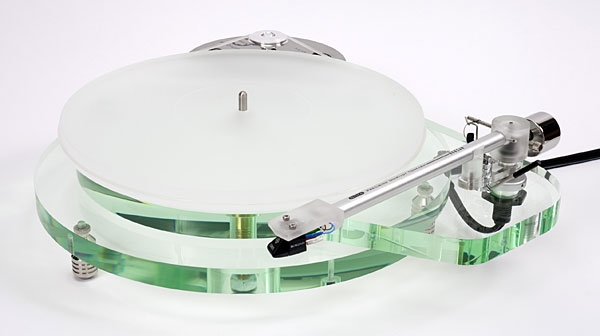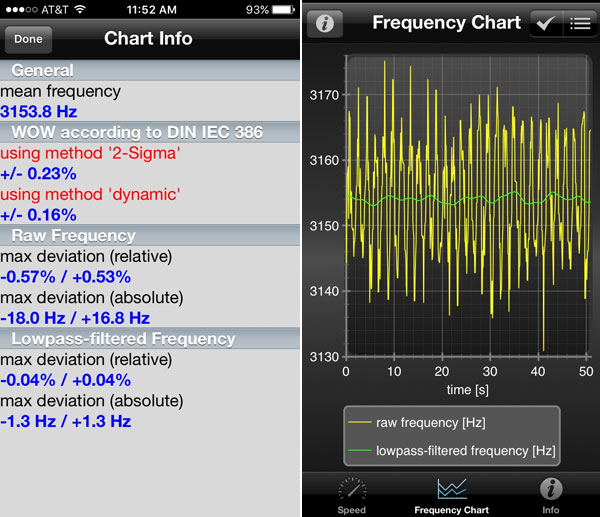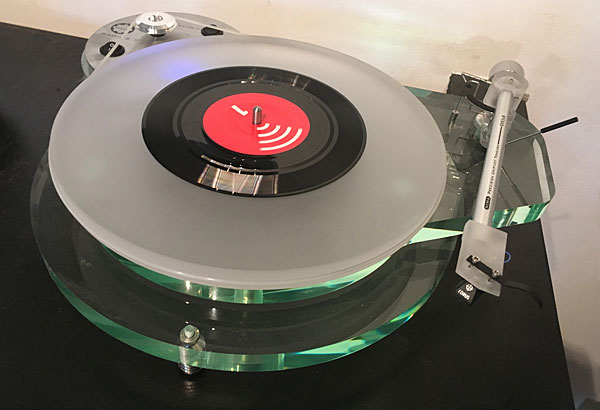| Columns Retired Columns & Blogs |
The spirit of the Michell Syncro is resurrected!
http://www.iavscanada.com/wordpress/wp-content/uploads/Innovative-Audio-J.A.-Michell-Syncro-F1.jpg

When I was José Cuervo young, I mocked belt-drive turntables, unipivot tonearms, and teetotalers. "You can't drink, dance, shoot up the bar, and play hot records wit no persnickety belt-drive or wobbly unipivot. You need a masculine, pro-fessional-quality direct-drive or rim-drive turntable with a sturdy a gimbal-bearing tonearm!"
It feels like blasphemy, but now that I am a sober, tea-drinking, LP-collecting geezer, my reference turntable is a Linn Sondek LP12. And I am, with only mild chagrin, really digging Roksan Audio's new Radius 7 turntable ($3500 with Roksan Nima tonearm)—which surely is a persnickety belt-drive unipivot contrivance if ever there was one.
The Radius 7's dual-layer Perspex chassis and its acrylic platter are architecturally beautiful—especially when they light up and glow greenish red or blue in the dark. My partner, bb, says that it's the most beautiful bit of audio gear ever to cross the threshold of my man cave. (Obviously, everything I mock, I become.)
Measuring the Groove with Respect to Time
More important, almost none of the Radius 7's partner-pleasing beauty is mere marketing frivolity. Other than the lights, every component of the Radius 7 is the result of engineering ideas that have been fastidiously refined since the introduction of the original Roksan Xerxes turntable, in 1985. Back then, devotees of the Linn Sondek LP12 turntable were called flat-earthers and even had their own magazine: The Flat Response, which in 1986 morphed into a magazine called Hi-Fi Review. I can still remember the day that Malcolm Steward of Hi-Fi Review gave the Xerxes a positive review. (Brexit was nothing compared to this!) Former flat-earther Art Dudley declared this radical Roksan "profoundly influential" and said that the Xerxes "broke the Linn-Naim stranglehold in the UK. Art explained: "Before Roksan, people who valued a component's rhythmic and melodic capabilities had only one real turntable of choice, the (still splendid) Linn LP12."
The original Xerxes was designed by Roksan's founder and chief engineer, Touraj Moghaddam (he has since founded Vertere Acoustics) and employed several design innovations that, in Moghaddam's words, allowed it to "measure the groove better" and rise up against the colonizing power of the ubiquitous LP12. The first and most blasphemous of Moghaddam's innovations was to eliminate the traditional suspended subchassis used by AR, Ariston, Linn, and Thorens. He substituted a solid, well-damped "sub plinth" designed to overcome the problem of the motor-driven record platter torqueing the sprung subchassis in response to stylus drag and changing belt tension. To complement this speed-stabilizing invention, Moghaddam mounted the motor on a bearing so that it could rotate on its own axis; he limited this rotation by tethering it to a weak spring.
More subtle, but surely of equal importance, was Moghaddam's creation of a platter bearing with a very slender shaft that rotated on a tiny, superhard ball. By reducing contact area and speed, this innovative bearing reduced friction and, to my ears, increased the recovery of microdetail.
While the Radius 7 doesn't include this slender bearing, the thick Perspex platform on which the bearing, platter, and tonearm are rigidly mounted is likely as good as or better than the subplinth of its famous ancestor.
Also, instead of being mounted on a bearing, the Radius 7's motor is suspended on rubbery fasteners so that it's free to wobble in (only) two directions perpendicular to the motor-bearing axis. Unlike the Radius 5.2, the 7 uses a completely new motor with electronic speed selection (331/3and 45rpm). When the user selects 331/3rpm and switches on the motor, a blue LED within the chassis flashes. It stops flashing when full speed stability is attained. When 45rpm is chosen, a red LED flashes. The Roksan 7's speed accuracy was excellent (figs.1 & 2).

Roksan Nima tonearm
The Nima unipivot tonearm costs $1100 when purchased separately. (The Radius 7 by itself sells for $2500.) My review sample of the Radius 7 came with a Nima already installed. Its acrylic headshell and bearing yoke are separated by an aluminum armtube that feels paper-thin and undamped. A chrome counterweight protrudes from the bearing yoke's back, and a skinny calibrated shaft protrudes from its side; to the latter you attach a string from which a bias weight is suspended. I experimented, but ultimately kept the antiskating set at its minimum position.
Roksan Corus Silver cartridge
The Corus Silver moving-magnet cartridge replaces in the Roksan line the longstanding and highly favored Corus Black. It costs $1000 when purchased separately, but the Radius 7 with Nima and Corus Silver costs only $4000—the complete package saves you a total of $600. The Silver has a Goldring body and a Gyger II stylus, with a Roksan-specified suspension on the latter's cantilever. I am a forever fan of the Corus Black and two other, similarly Goldring-sourced MM cartridges, the Audio Note IQ2 and IQ3—and, of course, Goldring's own 1022 and 1042 cartridges. So I was excited to hear the Corus Silver.
Setup
As I set up the Radius 7, I cursed and swore: Mounting a cartridge on a wobbly, feather-light tonearm was daunting. Determined to do my best alignment ever, I carefully pressed on. I couldn't use my Dr. Feickert Analogue protractor because its aluminum base was too heavy and unbalanced—it tipped the 7's platter off its bearing mount. Fortunately, my Acoustical Systems SMARTractor balanced naturally around the Radius 7's spindle and worked just fine.
I precisely adjusted the Corus Silver's vertical tracking force (VTF). Then I zeroed in the azimuth. But that changed the VTF. So I fixed the VTF—and the azimuth was off again. My LED flashlights and magnifiers were scattered everywhere. Finally, I got it right and felt extremely good about the sonic results.
Most of my listening to the Roksan combo was done with a Parasound Halo JC 3+ phono stage driving a Rogue Audio RP-1 or Pass Labs HPA-1 preamplifier driving the First Watt J2 stereo amplifier, itself driving DeVore Fidelity Orangutan O/93 loudspeakers.
Listening
Sometimes, I can put on a single record and the whole story becomes immediately apparent. Such was the case with the Roksan Radius 7. Once I'd gotten it set up, I wanted to put on some piano music so I could listen for wow and flutter. Not in the mood for Schnabel or Gieseking, I put on Chansons de Léo Ferré, a 1953 recording of songs written, sung, and played by Léo Ferré (10" mono LP, Le Chant du Monde LD-M-4022)—which never before had sounded this richly construed or properly re-created. I'd played this disc on several six-figure systems, and it had never sounded this fundamentally right or musically satisfying.
Piano notes and Ferré's eccentric vocal expressions led into one another in a captivating way. Everything felt so Paris 1953 that I barely noticed when Simone Signoret and Yves Montand entered my painter's garret. Wow and flutter? Insignificant—and piano tone was exceptional in both texture and color. Ferré's voice was vivid and present, but in that special "1953 microphone" way. (Montand smiled approvingly as he uncorked the wine.) The Roksan Radius 7 turntable, Nima tonearm, and Corus Silver cartridge sounded impressively rich and exceptionally musical right out of the box.
Feeling the need to impress my handsome French guests, I put on something current and super-hip: "Sketch," performed by the Modern Jazz Quartet and the Beaux Arts String Quartet, from the MJQ's Third Stream Music (LP, Atlantic 1345). This combination of violins, viola, cello, Milt Jackson's vibraphone, and John Lewis's sprightly, driving piano melodies made us all close our eyes and relax our heads.
Record after record felt easy and natural, overflowing with luminous LSD detail. I was in heaven.

Comparisons
The Roksan Radius 7 with Nima tonearm costs about the same as two other 'tables I've reviewed: the Acoustic Signature WOW XL ($2395) with TA-1000 tonearm ($1595), and the new Technics SL-1200GAE ($4000 with arm). All three play records with the high levels of authority and finesse that you'd expect at these prices. But each presented recordings with a sonic character distinctly different from the others.
I remember the sound of the WOW XL with TA-1000 and Ortofon Black cartridge as being precise, engaging, and musically forceful, but sometimes a touch hard or grayish. Color saturation and rumba factor were best with the Soundsmith Carmen moving-iron cartridge.
The strong points of the Technics SL-1200GAE are its spectacular imaging, low noise floor, steadfast authority, and super-high boogie factor. Its pace, rhythm, and timekeeping exceed those of even my Linn LP12. But sometimes, like the Acoustic Signature, it sounded a bit hard and gray.
Neither the WOW XL's nor the SL-1200GAE's delivery of tones and tempos could be described as sounding supple or viscous. Neither presented music in a way I would describe as sounding unusually rich or relaxed. But the Roksan Radius 7 (and my Linn LP12) had an unmistakable way of presenting music with a most natural and free-flowing viscosity—which always, and automatically, shuttles my mind away from hi-fi sound and back into the songs I'm playing.

The spirit of the Michell Syncro is resurrected!
http://www.iavscanada.com/wordpress/wp-content/uploads/Innovative-Audio-J.A.-Michell-Syncro-F1.jpg

"the Utopias are less juicy-wet, musically charged, and rampantly fun than my everyday references", perhaps less coloration so less distorsion. For the turntables, I find it totally impossible to say one is really better than another, at ANY price, so I'm not spending money for that anymore, sorry.

However I take issue with his phrase "Jose Cuervo young" unless it is to indicate that as one gets older, one prefers better tequila...
Please keep it up, Herb!